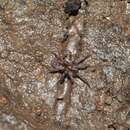en
names in breadcrumbs


Orepukia is a genus of South Pacific araneomorph spiders in the family Cycloctenidae, known only from New Zealand. First described by Raymond Robert Forster & C. L. Wilton in 1973,[2] it was originally placed in Agelenidae, but was transferred to Cycloctenidae in 2017.[3] Their webs are built on the ground between fallen branches, logs, and other debris, and they are commonly found on the South Island, but hardly ever anywhere else.[2] They range in size from 6 to 7.5 millimetres (0.24 to 0.30 in) and lack a cribellum. Their eight eyes are in two rows, the anterior row straight and the other slightly curved. Their jaws are vertical and the labium is notched near the base.[2]
As of April 2019 it contains twenty-four species:[1]
Orepukia is a genus of South Pacific araneomorph spiders in the family Cycloctenidae, known only from New Zealand. First described by Raymond Robert Forster & C. L. Wilton in 1973, it was originally placed in Agelenidae, but was transferred to Cycloctenidae in 2017. Their webs are built on the ground between fallen branches, logs, and other debris, and they are commonly found on the South Island, but hardly ever anywhere else. They range in size from 6 to 7.5 millimetres (0.24 to 0.30 in) and lack a cribellum. Their eight eyes are in two rows, the anterior row straight and the other slightly curved. Their jaws are vertical and the labium is notched near the base.